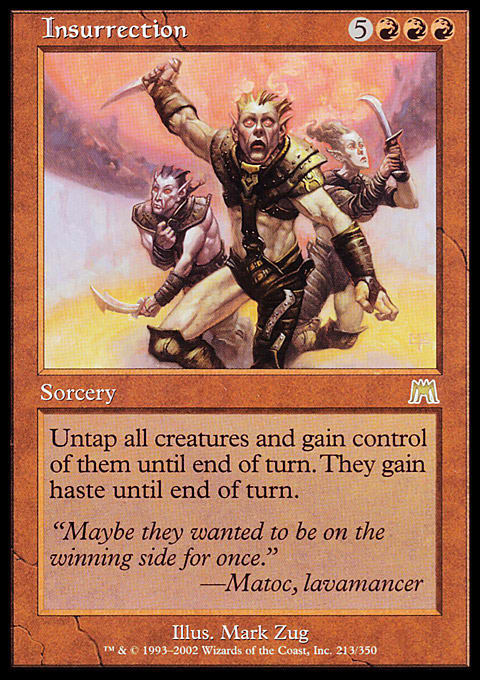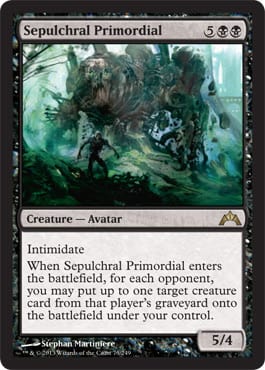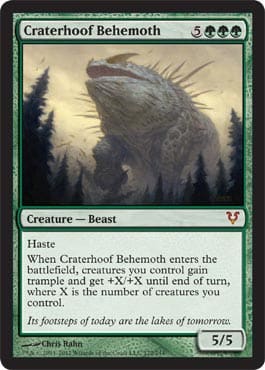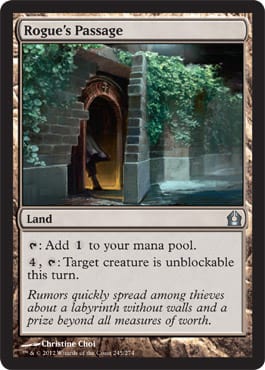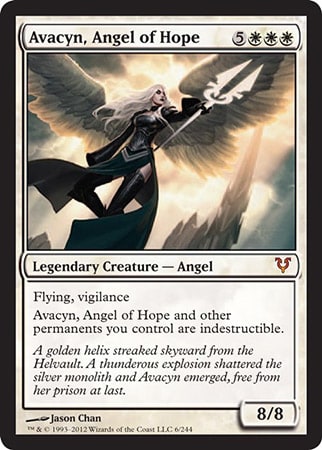We all have our most beloved and behated cards, and that variety is what makes casual Magic so awesome. However, there is a difference between cool cards and cool games, and playing the most powerful cards can sometimes lead to unfun and frustrating games. What I want to talk about today is not the cards themselves, but the effects some cards are having on games and metagames. I argue that Wizards of the Coast is letting the power creep of recent years distort the Kitchen Table metagame.
Here are five popular cards that I think are having bad effects on multiplayer Magic. To keep things constructive and non-ranty, every card is accompanied by a design suggestion for the good folks at Wizards.
1 — The Insurrection Paradox
The basic idea of the Timmy psychographic, which has guided Wizards R&D for more than a decade, is that Timmies love to make The Big Play™, but that’s only half true; what we really want is a game in which many big plays are made, which is why I have come to hate Insurrection.
Don’t get me wrong; it gave me wood at first sight—Insurrection is exactly the kind of card a Timmy like me gravitates toward, but then, one fateful game, I realized just how bad it could be. See if this sounds familiar: I was absolutely mana-flooded all game, and the handful of permanents I could play were killed as soon as they entered the battlefield . . . until I top-decked Insurrection. I had the mana, so I played Insurrection, attacked, and won.1
The initial excitement of that play faded almost immediately when I realized that my one card had invalidated everything else my opponents had done in the whole game. It was a big play, but it made the game worse, not better, for everyone involved. That is the Insurrection Paradox—cards that look like a Timmy wet dream but that lead to less interesting games.
My advice to Wizards is simple: Try to give Timmy games in which many big plays are possible, rather than game-ending plays that stop the fun for everyone else.
2 — If It Costs X, It Should Win You the Game
This has long been a cliché in Constructed play. I think the number was originally 6, meaning that you should never play a card that costs 6 mana unless it wins you the game on the spot (think of the single Amnesia in Brian Weisman’s famous deck,2 or the Invasion-era decks that finished with Rith, the Awakener). For casual players, we have tended to ignore this rule because games last longer and more expensive cards are usually cooler. However, Wizards now has a tendency to say, “Any ability is okay if the CMC3 is high enough,” and the net effect of this is negative for multiplayer.
Primal Surge is a cool ability that we’d never seen before, at least on a single card. I remember watching in awe as my buddy Mike first played Primal Surge in his creatures-only Animar, Soul of Elements deck and cheering as his army of freshly-summoned-yet-hasty beaters crushed the whole table. It was like a Genesis Wave, where X equals your deck. But now I’ve seen it enough times that the thrill is gone; there are no new tricks to be done with that card. Even worse, think about the strategic position when you know an opponent has built his or her deck around Primal Surge: Even if he or she has a weak board position, you feel compelled to take him or her out before he or she reaches 10 mana because the risk of him or her auto-winning from casting that one card is just too high.4
Consider also cards like Enter the Infinite and Omniscience. Back in the day, if you wanted to achieve these kinds of jaw-dropping effects, you had to achieve some incredibly baroque nine-card combo, which would be the focus of your deck. You might never get it off, but when you did, it would be the stuff of legend: a play that your opponents would be telling stories about decades later.
Now all you have to do is drop your tenth land.
Wizards needs to remember that multiplayer games are going to see very high levels of mana, but nobody should win just because they achieved a certain mana threshold. My advice for Wizards is to create absolutely ridiculous things are best achieved in a Johnny-ish fashion, requiring clever interactions, rather than printing individual cards that convert mana into absurdity.
3 — Enforced Obsolescence
Okay, mea culpa time: I play the crap out of Sepulchral Primordial! I love him, but I hate what he does to the game.
The Primordial cycle from Gatecrash is an extreme example of power creep, making cards that are far ahead of anything else ever printed. These stronger cards inevitably become ubiquitous, making older cards obsolete. Think about it: How many fatties from Magic's history are better than a Primordial? There are a couple of the Praetors maybe, and depending on your deck, other cards might make it on the basis of flavor or synergy, but the Primordials are basically the most powerful multiplayer cards ever made for their costs, and that makes games worse, not better. Decks become Primordial delivery devices, and games became about who controls the most Primordials. I imagine you’ve all seen a few games that ended very quickly when one player achieved “Primordial supremacy;” perhaps a Sepulchral Primordial reanimated other Primordials or Diluvian Primordial copied a kicked Rite of Replication. When so many games revolve around a single cycle of cards, metagames are clearly out of balance.
Craterhoof Behemoth is another example, overpowering every top-of-the-curve beater ever made in most green decks. Sure, you could play an older creature and make something bigger than a 5/5, but Craterhoof Behemoth is usually capable of taking out at least one opponent when you play it, and it can sweep the table from any number of fairly common board states (but hey, if it costs 8 mana, it should win you the game, right?. Craterhoof Behemoth sometimes seems like a Primal Surge with legs). There’s no need to choose the right card for each deck when one card is clearly superior, and that reduces variance and fun.5
But here’s the thing: Casual is an Eternal format. The Casual Tribe plays with the broadest possible range of cards from Magic’s vast history. That’s why I suggest that Wizards try to give us new toys to play with while leaving us with choices about whether the newest card is better for our decks.
I will go on hypocritically playing with Sepulchral Primordial—because everyone else is packing Primordials, and I will lose if I don’t follow the crowd. But I will feel dirty every time I accidentally win with it . . . and I will live in constant fear of the inevitable day when Wizards makes a card so good that it even obsoletes the Primordials.
4 — Reducing Interaction
Casual Magic is about interaction at all three levels: strategic, political, and social. And yet, too many new cards are designed to reduce that interaction. Rogue's Passage exemplifies this trend, going into any deck and having the potential to turn a slugfest into a one-shot, combo-esque knockout. Even the ubiquitous Lightning Boots greatly reduce interaction, as haste makes blocking harder, and shroud and hexproof make dealing with the attacker any other way much more challenging.
And unblockable beaters are just boner-killers.
I understand why they make cards like this: They're trying to solve the problem of games becoming deadlocked. Making a huge beater unblockable is one way to break a stalemate, but my feeling is that it shouldn’t be the main way—it is a major downer in multiplayer. A Wizards of the Coast honcho once described shadow as “the worst Magic mechanic ever,”6 because it reduced interaction so much, but Rogue's Passage is just as bad for exactly the same reason.
Dwarven Warriors and similar cards from the (good?) old days struck a better balance, allowing you to pick at an opponent’s heels with small, unblockable creatures (and then find other ways to pump them up). Rogue's Passage removes the play skill and strategy from this situation by allowing you to make any creature completely unblockable. Watching Omnath, Locus of Mana or Consuming Aberration attack you for unblockable lethal damage is just an unsatisfying way to die.
But does Wizards get it? Based on the fact that they put a ton of unblockable and landwalking stuff in Magic: The Gathering—Conspiracy, I’m not convinced they do. Remember that the set included Phage the Untouchable, and nothing says, “No Interaction Required,” like a Phage with Unquestioned Authority.
My advice to Wizards: Interactivity should be the first principle of multiplayer card design.
5 — Locking in the Lead
With apologies to Heather Lafferty, Avacyn, Angel of Hope is pushed past the point where she is any fun to play against. A lot of what I’ve already talked about applies to Avacyn as well: a stupidly powerful ability that is assumed to be balanced just because it is so expensive, the undeniable top of the mono-white mana curve,7 and an ability that eliminates most of the ways that your opponents can interact with you. Indestructible is among the strongest mechanics in the game, and it has a far greater effect in multiplayer than Wizards seems to realize. Individual cards with indestructible are hard to deal with, but they are usually manageable; however, making all of your team indestructible shuts down too many options and nullifies interaction with minimal effort.
It wasn’t always the case though; once again, we can see power creep in action. Indestructible premiered in Darksteel, and the only card worth playing was Darksteel Colossus, a fearsome fatty, but hard to cast and almost impossible to reanimate. The other indestructible creatures in the block tended to weak and overcosted.
Fast forward to Kamigawa block, and we saw the Myojin cycle, another set of cards that represent the it-doesn’t-matter-how-powerful-they-are-if-they-cost-X school of design. They are indestructible until you activate their ridiculously broken abilities, by which time you have probably won the game, but they cost 8 or 9 mana, and they only gain the divinity counters if you played them fair, so they weren’t totally unbalanced.
Indestructible really surged in popularity in multiplayer with Spearbreaker Behemoth and Darksteel Plate, both of which are (too?) strong, but they at least force you to make decisions about what to protect and what to leave vulnerable. Things got out of hand (at least in my opinion) with Avacyn, Boros Charm, and Rootborn Defenses, which extend blanket protection to everything on your side of the table, leaving your opponents with few options and you with no interesting decisions to make.
The bottom line is that not all mechanics are created equal. Giving all of your creatures flying, vigilance, or first strike is powerful, but not as reliably swingy as something like indestructible. Indestructible says to most of your opponents that they don’t have more than two cards in their decks that can deal with your team, and if they can’t find it in the next couple of turns, they may as well not bother.
My advice to Wizards: Start costing keywords based partly on their impact on multiplayer, rather than designing purely for Standard and forcing us to deal with the consequences.
What Timmy Wants
Wizards of the Coast makes cards, and the cards shape the games. I would really like to see Wizards taking more effort to think about the casual games that their cards will lead to—instead of making bigger, splashier cards that lead to smaller, less interesting games. We like powerful cards, Wizards—really, we do—but we want to win games with our play, not just be casting single, unbalanced cards. We know you’re listening, and we’re confident that you guys are smart and creative enough to get the balance right . . . once you understand what multiplayer is really all about!
1 Obviously, there will be times when Insurrection is just a very expensive Threaten or Mass Mutiny, but almost any multiplayer game is going to see board states from which a single Insurrection will kill at least half of your opponents. Worse, it is most likely to take out the players who are most active, making it overly swingy.
3 Converted mana cost: the total amount of mana required to play a spell.
4 Again, I am aware of the various ways of dealing with Primal Surge—Darkness followed by Merciless Eviction for creatures is a favorite, but Gather Specimens will work in a pinch—but the fact remains that it is often if not usually a one-shot kill against the entire table in any deck designed to use it.
5 Contrast this with Terastodon, which is huge and brutally powerful, but which has a lot more variance than Craterhoof Behemoth, but also, crucially, requires you to make more decisions and deal with the trade-offs.
6 Randy Buehler, former lead developer, quoted in this article.
7 Rule of thumb: Any card that makes Akroma, Angel of Wrath look underpowered is probably too good.













